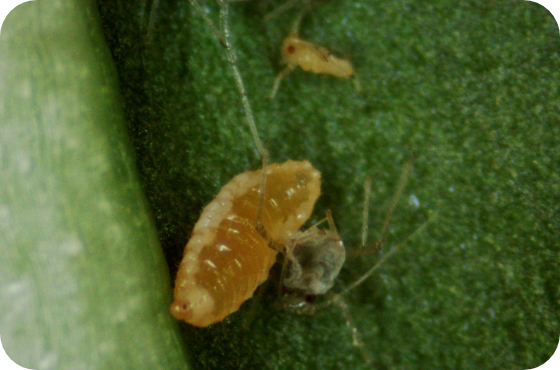Quality Products
Fast Delivery
Premium Service
Written by Kevin van Kester | Last update: 26. June 2023
Gall midge Aphidoletes aphidimyza is a natural enemy of aphids. This beneficial insect is highly effective for organic aphid control in greenhouse environments. It's known to target more than 60 species of aphids, with the larvae being especially effective at reducing aphid populations not only in tomato aphid control, but in a great variety of crops.

Aphidoletes are nocturnal insects that become active at dusk and during the night. Female Aphidoletes are skilled at locating aphid hotspots and lay their eggs in these nutrient-rich areas. The eggs, which are tiny and range in colour from orange to red, are almost invisible to the naked eye and will hatch in about 2 to 5 days.
Once hatched, the larvae emerge as effective biological control agents. These larvae target aphids, often killing more than they consume. They inject a paralyzing substance into their prey, then extract the body’s contents, leaving behind only the empty skin. Although the larvae are typically orange, their colour can vary depending on the aphid species they feed on.
Effective in controlling various aphid species, including black bean aphids control and black aphid control, Aphidoletes aphidimyza is a reliable biological solution. These predatory midges actively hunt down aphids, reducing infestations efficiently.
Aphidoletes aphidimyza larvae consume 10 to 100 aphids before moving on to the next stage. After feeding for 5 to 10 days, the larva drops from the leaf to the ground to begin the pupation process. The larvae that are not able to reach the ground typically do not survive.
Within 8 to 16 days, an adult gall midge emerges from the pupa. The mating process takes place on the first night after the adult midge has hatched, with females living for approximately one week.
For optimal Aphidoletes gall midge development, it is important to maintain the right temperature and humidity. The ideal temperature range is between 20 to 30 °C, with air humidity levels kept at a minimum of 60%, and a day length of 16 hours. Nighttime temperatures should remain at a minimum of 12 to 16°C; if the temperature drops below 12°C, no egg deposition occurs.
Releasing a sufficient number of Aphidoletes when aphids are first detected is of high importance for optimal greenhouse aphid control. Aphidoletes are supplied as pupae in a carrier material. Depending on the product, there are two methods for releasing the gall midge pupae:
Our team of specialists checks the quality of the gall midges. Following a strict protocol, we ensure that only the highest quality is delivered to you. Watch the videos below for a detailed look at the gall midge and its application.
Aphidoletes can work effectively with spiders, as mating often occurs in their cobwebs. However, it does not pair well with Amblyseius swirskii mites. Additionally, the presence of sulphur in greenhouses can adversely affect the gall midge's ability to locate aphids.